ECON 201: Price Ceiling Effects on Demand and Supply Analysis
VerifiedAdded on 2020/03/16
|8
|1270
|360
Report
AI Summary
This economics report analyzes the effects of a price ceiling imposed by the government of Experimentia on the tertiary education market. The report examines how the price ceiling, designed to keep education costs low, impacts demand and supply, leading to shortages. It explores the effects of the price ceiling on prices, demand, and supply and compares the consequences of deregulation under elastic and inelastic supply scenarios. The analysis includes graphical representations of the market dynamics and discusses the effects on the efficiency and equity of the tertiary education market. The report also provides an overview of how policy changes, such as price liberalization, can affect consumer awareness and the quality of education provided by tertiary institutions. The conclusion highlights the impacts of price ceilings and deregulation on market efficiency and equity, emphasizing the roles of demand, supply, and price elasticity.
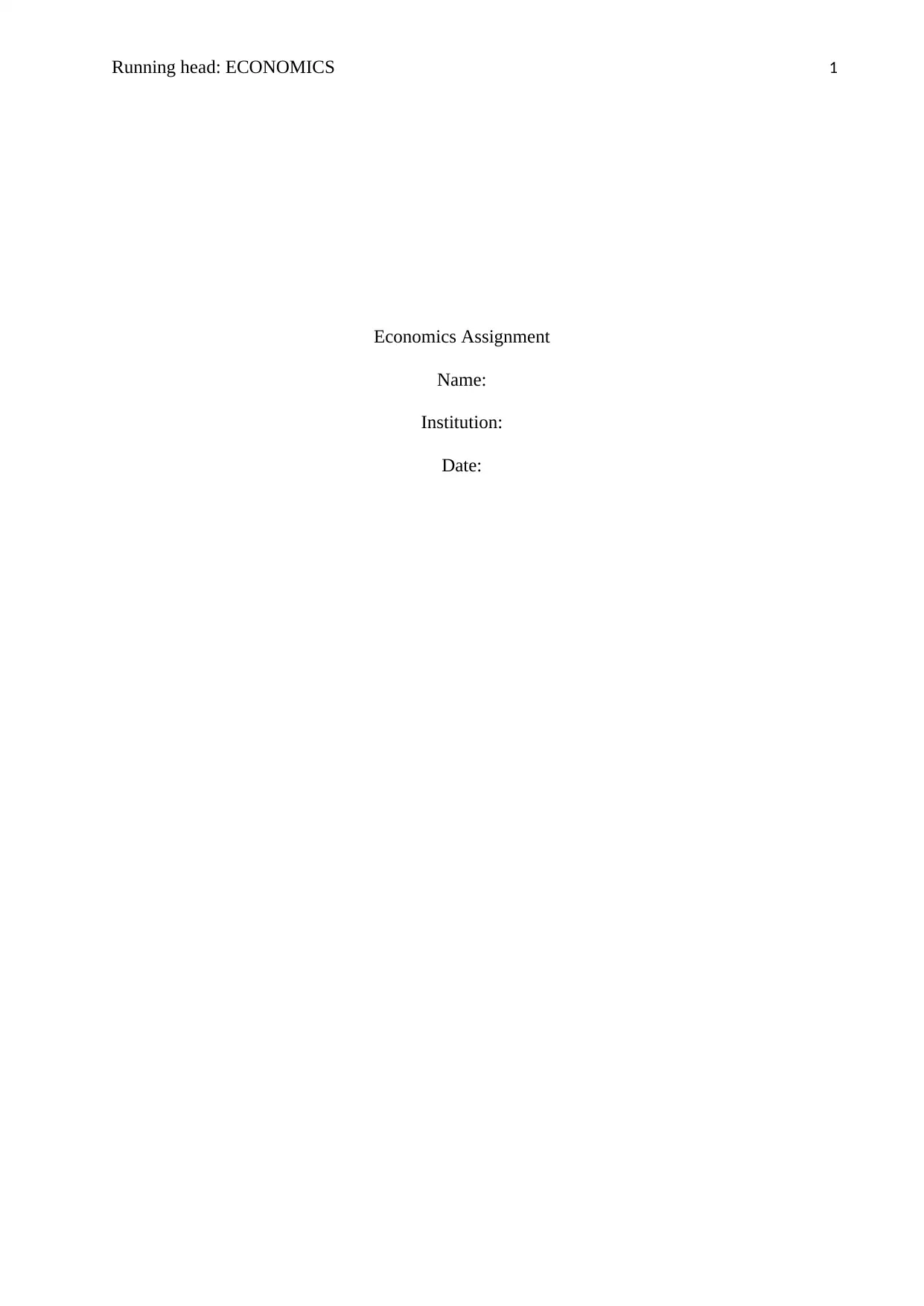
Running head: ECONOMICS 1
Economics Assignment
Name:
Institution:
Date:
Economics Assignment
Name:
Institution:
Date:
Paraphrase This Document
Need a fresh take? Get an instant paraphrase of this document with our AI Paraphraser
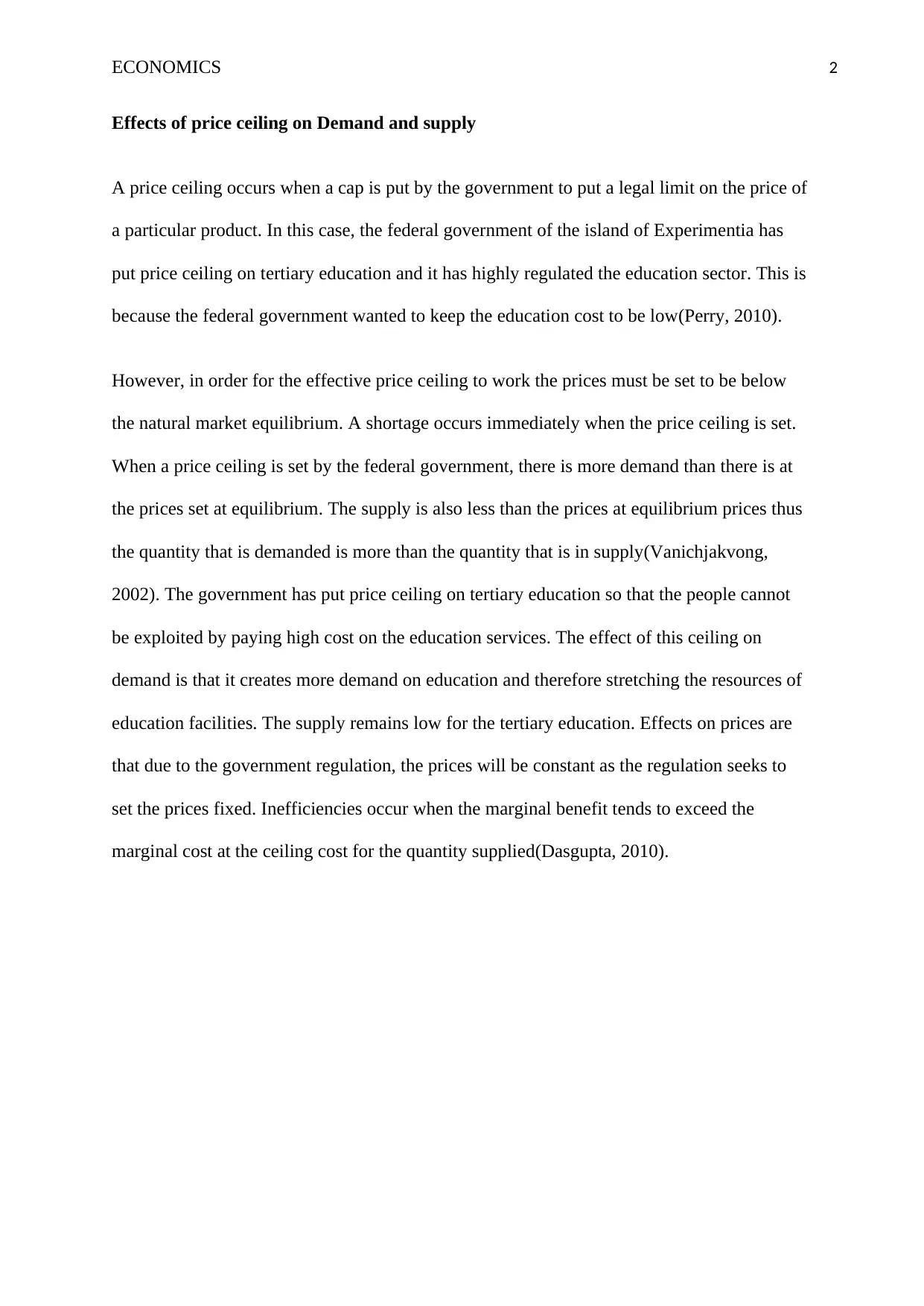
ECONOMICS 2
Effects of price ceiling on Demand and supply
A price ceiling occurs when a cap is put by the government to put a legal limit on the price of
a particular product. In this case, the federal government of the island of Experimentia has
put price ceiling on tertiary education and it has highly regulated the education sector. This is
because the federal government wanted to keep the education cost to be low(Perry, 2010).
However, in order for the effective price ceiling to work the prices must be set to be below
the natural market equilibrium. A shortage occurs immediately when the price ceiling is set.
When a price ceiling is set by the federal government, there is more demand than there is at
the prices set at equilibrium. The supply is also less than the prices at equilibrium prices thus
the quantity that is demanded is more than the quantity that is in supply(Vanichjakvong,
2002). The government has put price ceiling on tertiary education so that the people cannot
be exploited by paying high cost on the education services. The effect of this ceiling on
demand is that it creates more demand on education and therefore stretching the resources of
education facilities. The supply remains low for the tertiary education. Effects on prices are
that due to the government regulation, the prices will be constant as the regulation seeks to
set the prices fixed. Inefficiencies occur when the marginal benefit tends to exceed the
marginal cost at the ceiling cost for the quantity supplied(Dasgupta, 2010).
Effects of price ceiling on Demand and supply
A price ceiling occurs when a cap is put by the government to put a legal limit on the price of
a particular product. In this case, the federal government of the island of Experimentia has
put price ceiling on tertiary education and it has highly regulated the education sector. This is
because the federal government wanted to keep the education cost to be low(Perry, 2010).
However, in order for the effective price ceiling to work the prices must be set to be below
the natural market equilibrium. A shortage occurs immediately when the price ceiling is set.
When a price ceiling is set by the federal government, there is more demand than there is at
the prices set at equilibrium. The supply is also less than the prices at equilibrium prices thus
the quantity that is demanded is more than the quantity that is in supply(Vanichjakvong,
2002). The government has put price ceiling on tertiary education so that the people cannot
be exploited by paying high cost on the education services. The effect of this ceiling on
demand is that it creates more demand on education and therefore stretching the resources of
education facilities. The supply remains low for the tertiary education. Effects on prices are
that due to the government regulation, the prices will be constant as the regulation seeks to
set the prices fixed. Inefficiencies occur when the marginal benefit tends to exceed the
marginal cost at the ceiling cost for the quantity supplied(Dasgupta, 2010).
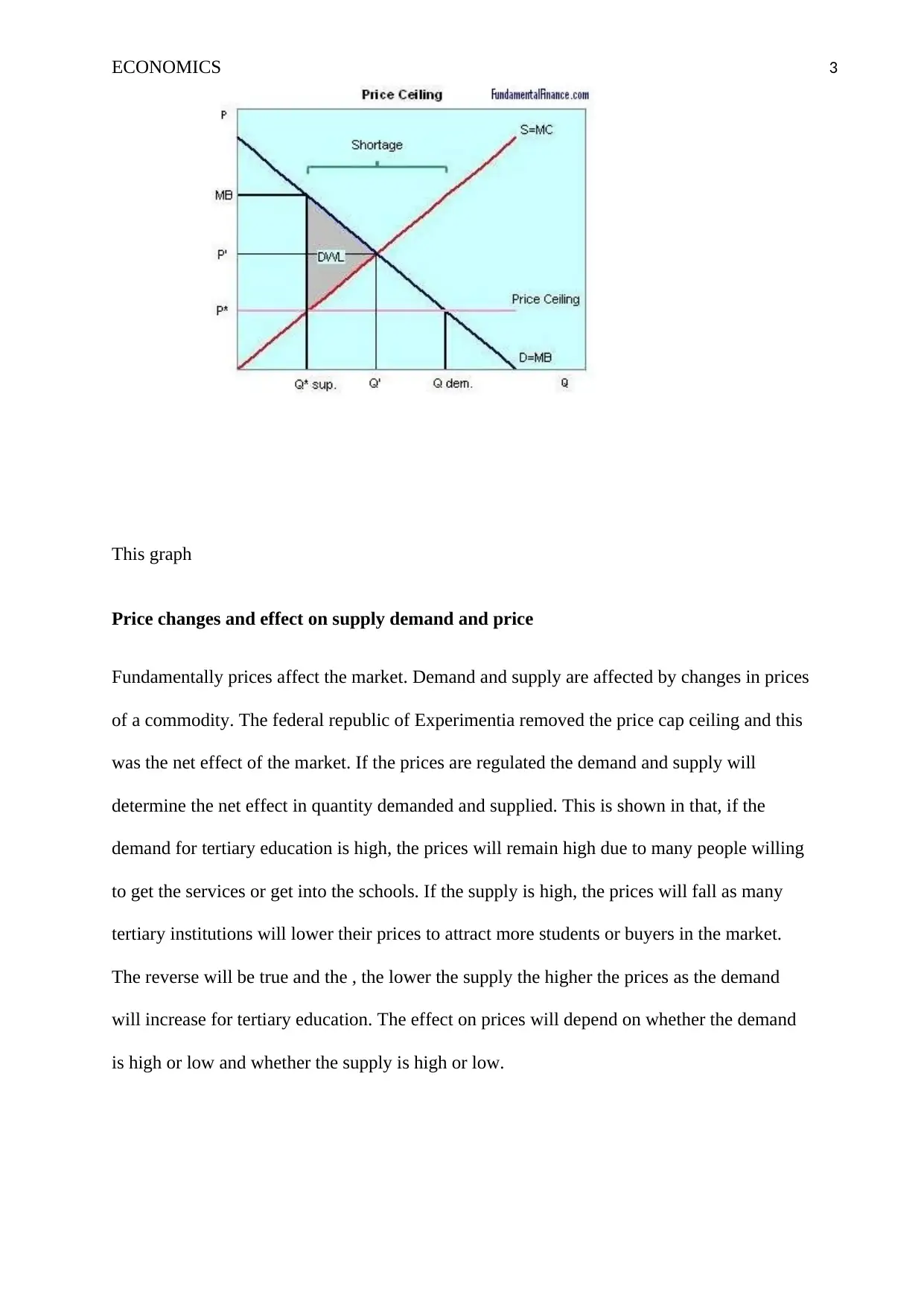
ECONOMICS 3
This graph
Price changes and effect on supply demand and price
Fundamentally prices affect the market. Demand and supply are affected by changes in prices
of a commodity. The federal republic of Experimentia removed the price cap ceiling and this
was the net effect of the market. If the prices are regulated the demand and supply will
determine the net effect in quantity demanded and supplied. This is shown in that, if the
demand for tertiary education is high, the prices will remain high due to many people willing
to get the services or get into the schools. If the supply is high, the prices will fall as many
tertiary institutions will lower their prices to attract more students or buyers in the market.
The reverse will be true and the , the lower the supply the higher the prices as the demand
will increase for tertiary education. The effect on prices will depend on whether the demand
is high or low and whether the supply is high or low.
This graph
Price changes and effect on supply demand and price
Fundamentally prices affect the market. Demand and supply are affected by changes in prices
of a commodity. The federal republic of Experimentia removed the price cap ceiling and this
was the net effect of the market. If the prices are regulated the demand and supply will
determine the net effect in quantity demanded and supplied. This is shown in that, if the
demand for tertiary education is high, the prices will remain high due to many people willing
to get the services or get into the schools. If the supply is high, the prices will fall as many
tertiary institutions will lower their prices to attract more students or buyers in the market.
The reverse will be true and the , the lower the supply the higher the prices as the demand
will increase for tertiary education. The effect on prices will depend on whether the demand
is high or low and whether the supply is high or low.
⊘ This is a preview!⊘
Do you want full access?
Subscribe today to unlock all pages.

Trusted by 1+ million students worldwide
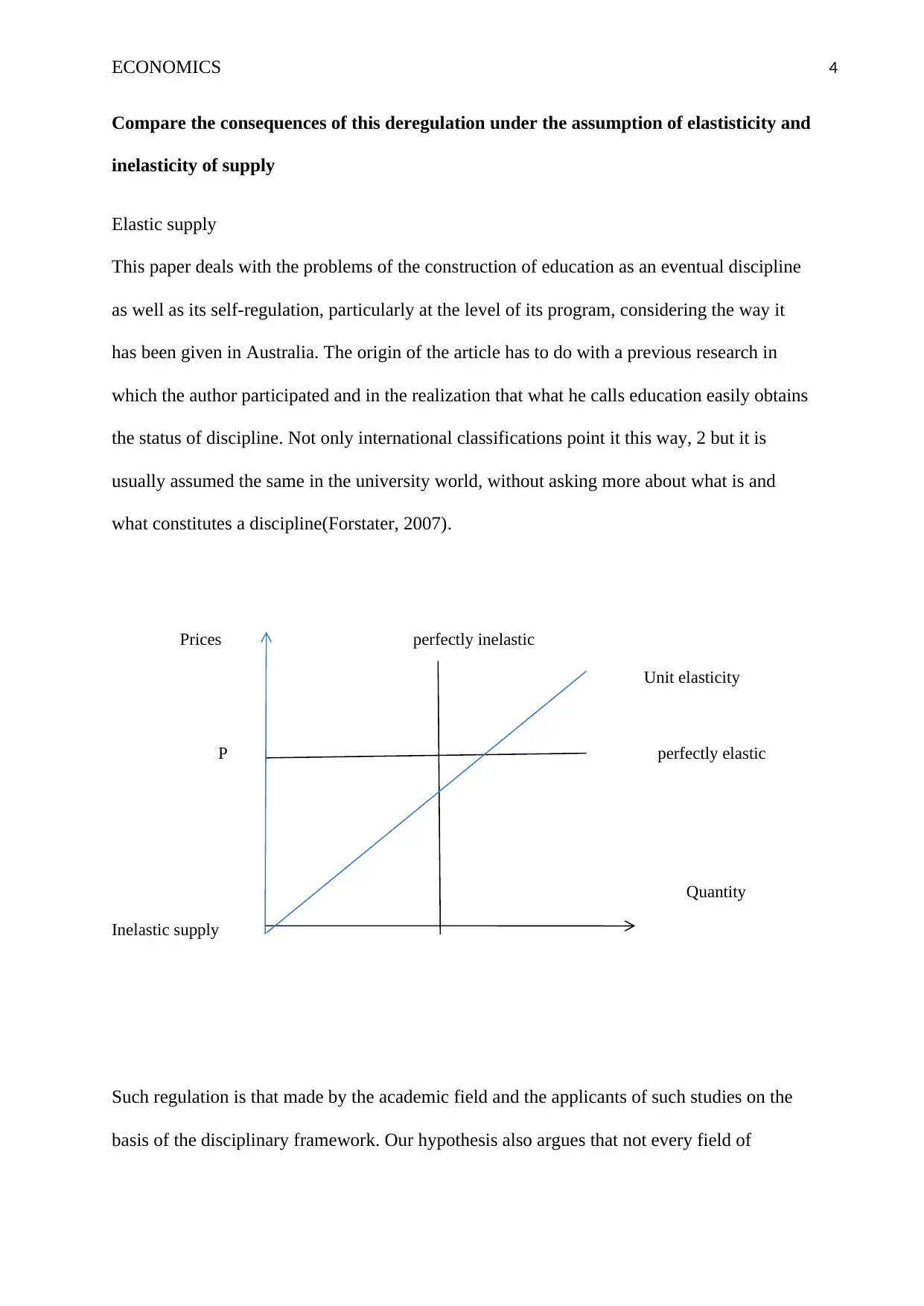
ECONOMICS 4
Compare the consequences of this deregulation under the assumption of elastisticity and
inelasticity of supply
Elastic supply
This paper deals with the problems of the construction of education as an eventual discipline
as well as its self-regulation, particularly at the level of its program, considering the way it
has been given in Australia. The origin of the article has to do with a previous research in
which the author participated and in the realization that what he calls education easily obtains
the status of discipline. Not only international classifications point it this way, 2 but it is
usually assumed the same in the university world, without asking more about what is and
what constitutes a discipline(Forstater, 2007).
Prices perfectly inelastic
Unit elasticity
P perfectly elastic
Quantity
Inelastic supply
Such regulation is that made by the academic field and the applicants of such studies on the
basis of the disciplinary framework. Our hypothesis also argues that not every field of
Compare the consequences of this deregulation under the assumption of elastisticity and
inelasticity of supply
Elastic supply
This paper deals with the problems of the construction of education as an eventual discipline
as well as its self-regulation, particularly at the level of its program, considering the way it
has been given in Australia. The origin of the article has to do with a previous research in
which the author participated and in the realization that what he calls education easily obtains
the status of discipline. Not only international classifications point it this way, 2 but it is
usually assumed the same in the university world, without asking more about what is and
what constitutes a discipline(Forstater, 2007).
Prices perfectly inelastic
Unit elasticity
P perfectly elastic
Quantity
Inelastic supply
Such regulation is that made by the academic field and the applicants of such studies on the
basis of the disciplinary framework. Our hypothesis also argues that not every field of
Paraphrase This Document
Need a fresh take? Get an instant paraphrase of this document with our AI Paraphraser
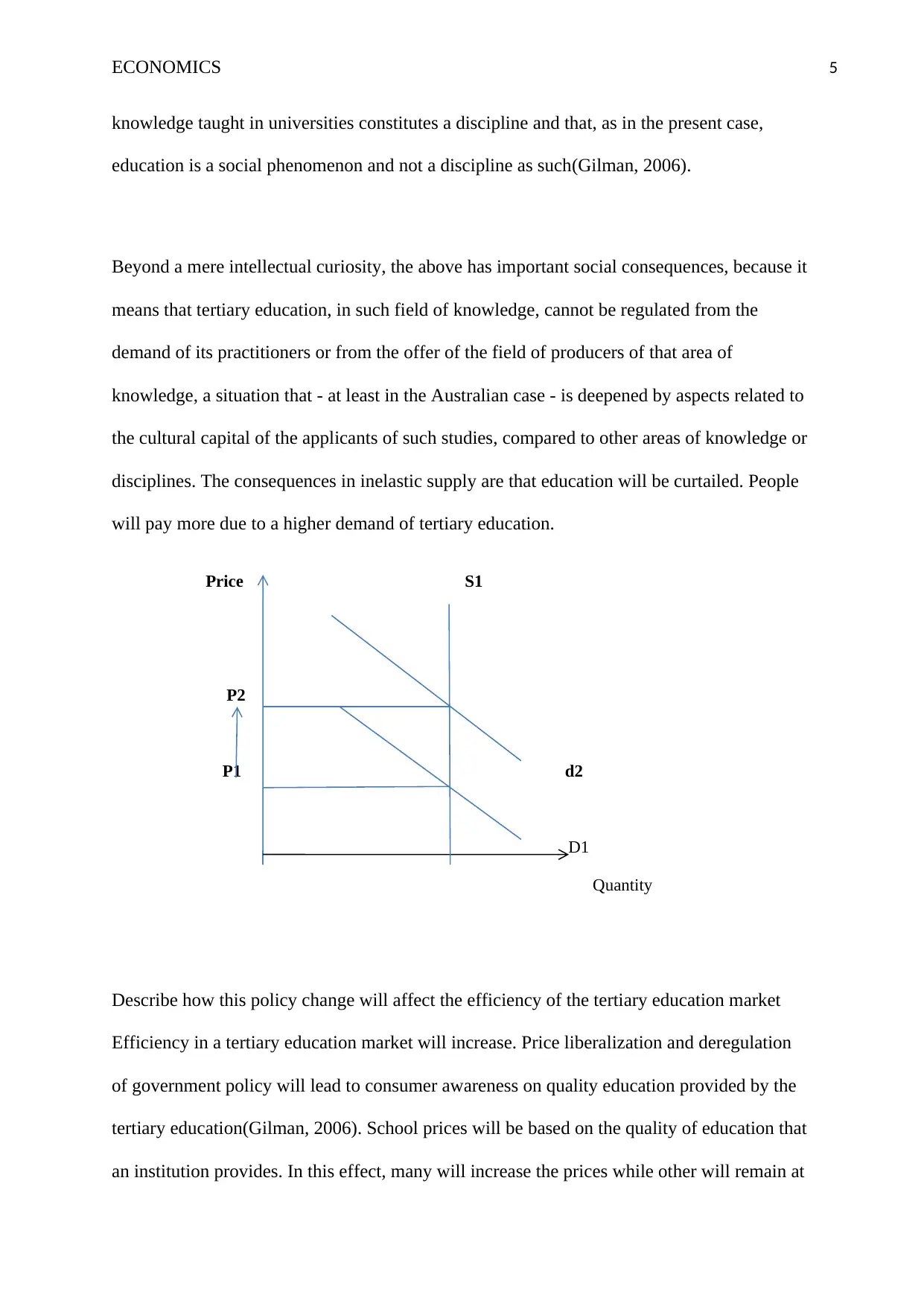
ECONOMICS 5
knowledge taught in universities constitutes a discipline and that, as in the present case,
education is a social phenomenon and not a discipline as such(Gilman, 2006).
Beyond a mere intellectual curiosity, the above has important social consequences, because it
means that tertiary education, in such field of knowledge, cannot be regulated from the
demand of its practitioners or from the offer of the field of producers of that area of
knowledge, a situation that - at least in the Australian case - is deepened by aspects related to
the cultural capital of the applicants of such studies, compared to other areas of knowledge or
disciplines. The consequences in inelastic supply are that education will be curtailed. People
will pay more due to a higher demand of tertiary education.
Price S1
P2
P1 d2
D1
Quantity
Describe how this policy change will affect the efficiency of the tertiary education market
Efficiency in a tertiary education market will increase. Price liberalization and deregulation
of government policy will lead to consumer awareness on quality education provided by the
tertiary education(Gilman, 2006). School prices will be based on the quality of education that
an institution provides. In this effect, many will increase the prices while other will remain at
knowledge taught in universities constitutes a discipline and that, as in the present case,
education is a social phenomenon and not a discipline as such(Gilman, 2006).
Beyond a mere intellectual curiosity, the above has important social consequences, because it
means that tertiary education, in such field of knowledge, cannot be regulated from the
demand of its practitioners or from the offer of the field of producers of that area of
knowledge, a situation that - at least in the Australian case - is deepened by aspects related to
the cultural capital of the applicants of such studies, compared to other areas of knowledge or
disciplines. The consequences in inelastic supply are that education will be curtailed. People
will pay more due to a higher demand of tertiary education.
Price S1
P2
P1 d2
D1
Quantity
Describe how this policy change will affect the efficiency of the tertiary education market
Efficiency in a tertiary education market will increase. Price liberalization and deregulation
of government policy will lead to consumer awareness on quality education provided by the
tertiary education(Gilman, 2006). School prices will be based on the quality of education that
an institution provides. In this effect, many will increase the prices while other will remain at
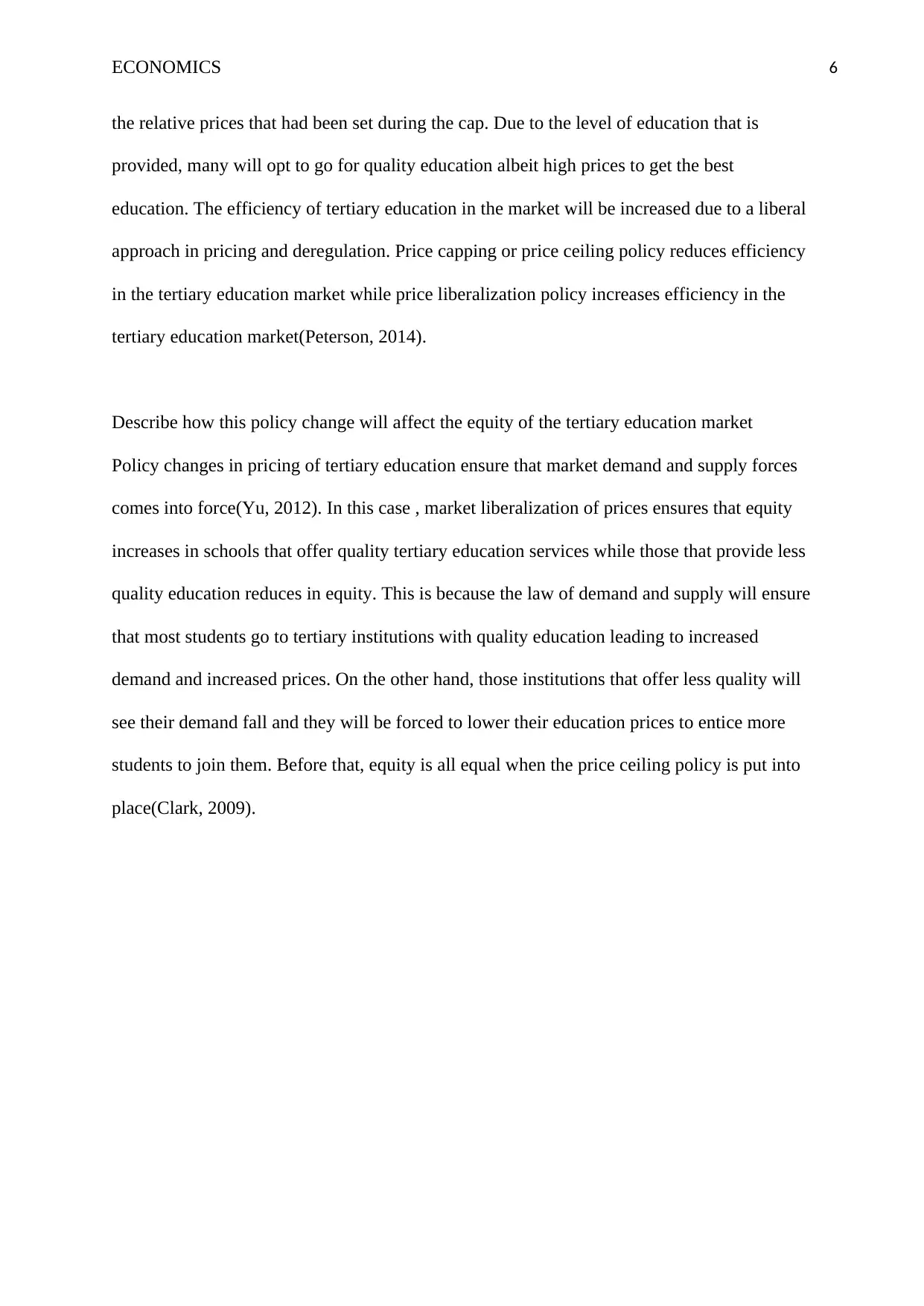
ECONOMICS 6
the relative prices that had been set during the cap. Due to the level of education that is
provided, many will opt to go for quality education albeit high prices to get the best
education. The efficiency of tertiary education in the market will be increased due to a liberal
approach in pricing and deregulation. Price capping or price ceiling policy reduces efficiency
in the tertiary education market while price liberalization policy increases efficiency in the
tertiary education market(Peterson, 2014).
Describe how this policy change will affect the equity of the tertiary education market
Policy changes in pricing of tertiary education ensure that market demand and supply forces
comes into force(Yu, 2012). In this case , market liberalization of prices ensures that equity
increases in schools that offer quality tertiary education services while those that provide less
quality education reduces in equity. This is because the law of demand and supply will ensure
that most students go to tertiary institutions with quality education leading to increased
demand and increased prices. On the other hand, those institutions that offer less quality will
see their demand fall and they will be forced to lower their education prices to entice more
students to join them. Before that, equity is all equal when the price ceiling policy is put into
place(Clark, 2009).
the relative prices that had been set during the cap. Due to the level of education that is
provided, many will opt to go for quality education albeit high prices to get the best
education. The efficiency of tertiary education in the market will be increased due to a liberal
approach in pricing and deregulation. Price capping or price ceiling policy reduces efficiency
in the tertiary education market while price liberalization policy increases efficiency in the
tertiary education market(Peterson, 2014).
Describe how this policy change will affect the equity of the tertiary education market
Policy changes in pricing of tertiary education ensure that market demand and supply forces
comes into force(Yu, 2012). In this case , market liberalization of prices ensures that equity
increases in schools that offer quality tertiary education services while those that provide less
quality education reduces in equity. This is because the law of demand and supply will ensure
that most students go to tertiary institutions with quality education leading to increased
demand and increased prices. On the other hand, those institutions that offer less quality will
see their demand fall and they will be forced to lower their education prices to entice more
students to join them. Before that, equity is all equal when the price ceiling policy is put into
place(Clark, 2009).
⊘ This is a preview!⊘
Do you want full access?
Subscribe today to unlock all pages.

Trusted by 1+ million students worldwide
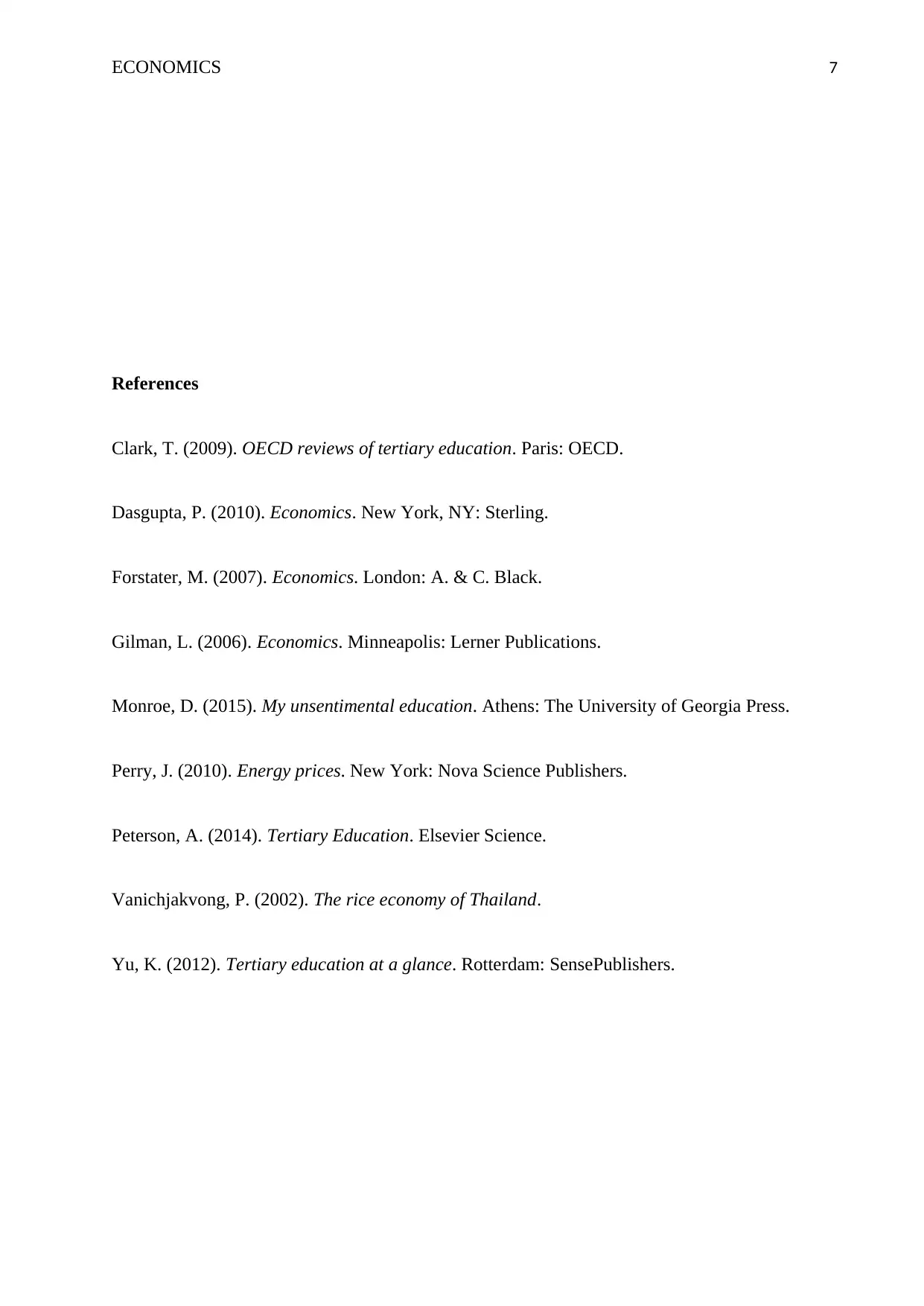
ECONOMICS 7
References
Clark, T. (2009). OECD reviews of tertiary education. Paris: OECD.
Dasgupta, P. (2010). Economics. New York, NY: Sterling.
Forstater, M. (2007). Economics. London: A. & C. Black.
Gilman, L. (2006). Economics. Minneapolis: Lerner Publications.
Monroe, D. (2015). My unsentimental education. Athens: The University of Georgia Press.
Perry, J. (2010). Energy prices. New York: Nova Science Publishers.
Peterson, A. (2014). Tertiary Education. Elsevier Science.
Vanichjakvong, P. (2002). The rice economy of Thailand.
Yu, K. (2012). Tertiary education at a glance. Rotterdam: SensePublishers.
References
Clark, T. (2009). OECD reviews of tertiary education. Paris: OECD.
Dasgupta, P. (2010). Economics. New York, NY: Sterling.
Forstater, M. (2007). Economics. London: A. & C. Black.
Gilman, L. (2006). Economics. Minneapolis: Lerner Publications.
Monroe, D. (2015). My unsentimental education. Athens: The University of Georgia Press.
Perry, J. (2010). Energy prices. New York: Nova Science Publishers.
Peterson, A. (2014). Tertiary Education. Elsevier Science.
Vanichjakvong, P. (2002). The rice economy of Thailand.
Yu, K. (2012). Tertiary education at a glance. Rotterdam: SensePublishers.
Paraphrase This Document
Need a fresh take? Get an instant paraphrase of this document with our AI Paraphraser
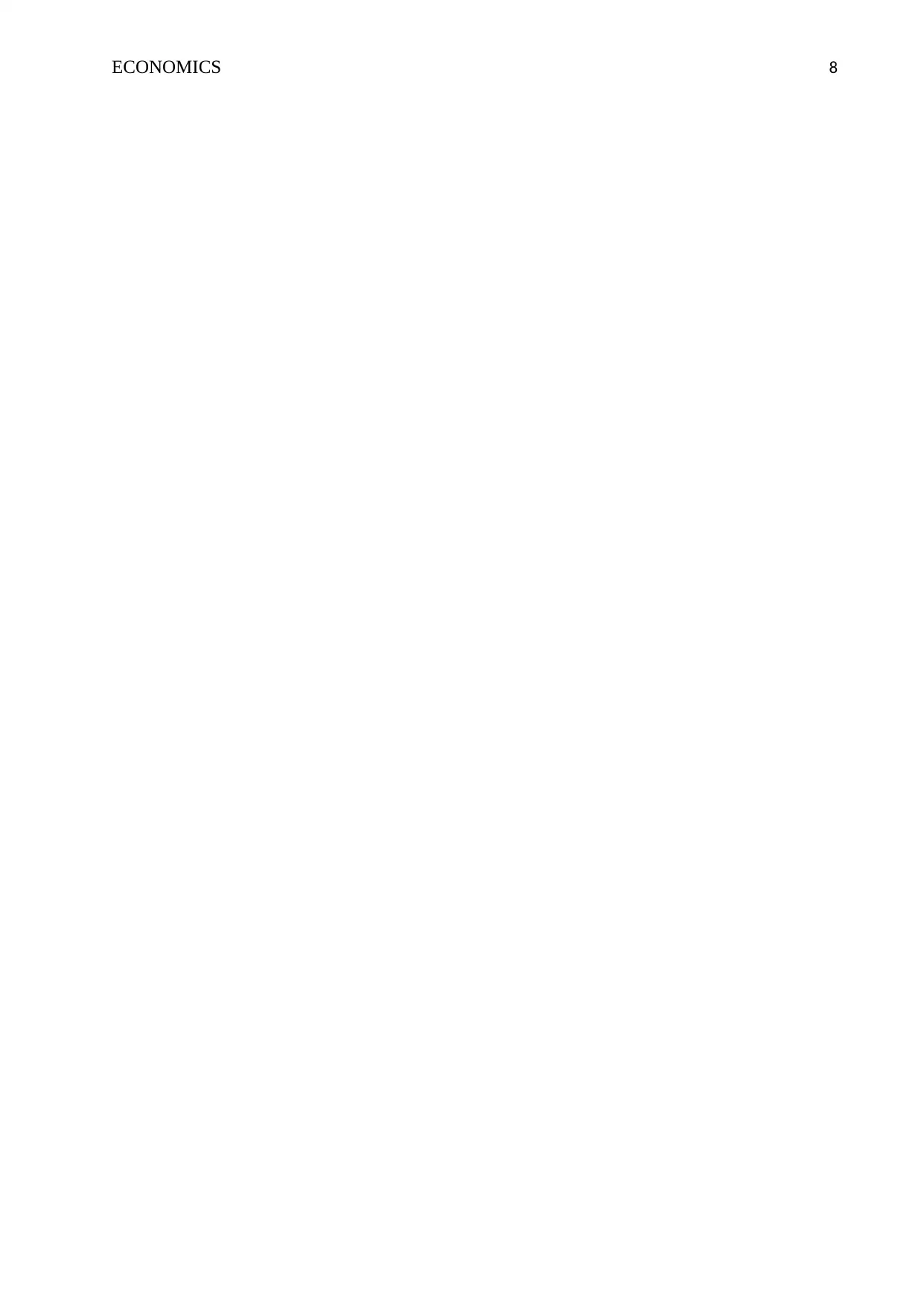
ECONOMICS 8
1 out of 8
Related Documents
Your All-in-One AI-Powered Toolkit for Academic Success.
+13062052269
info@desklib.com
Available 24*7 on WhatsApp / Email
![[object Object]](/_next/static/media/star-bottom.7253800d.svg)
Unlock your academic potential
Copyright © 2020–2025 A2Z Services. All Rights Reserved. Developed and managed by ZUCOL.





